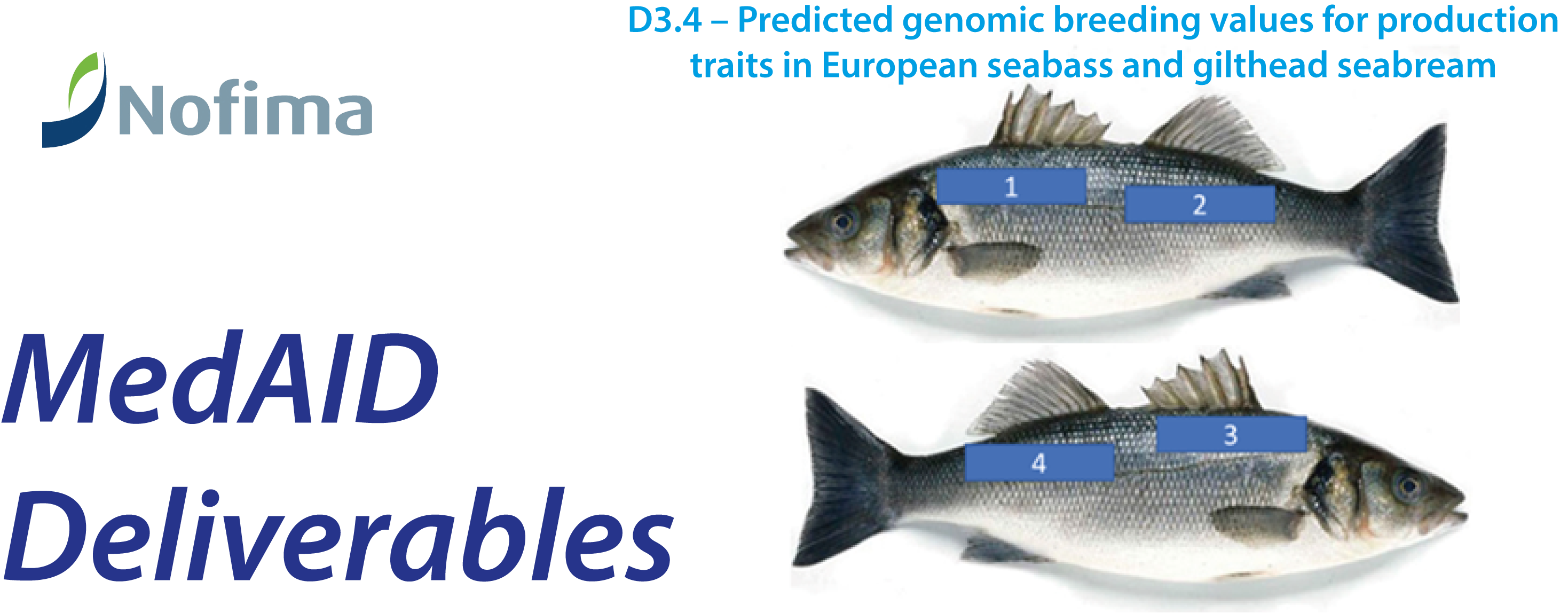Lipids are important in all animal production because they are linked to production efficiency, health and product quality. Excess dietary lipids that are not deposited in the edible muscle or used as energy source for growth are considered a loss and an indicator of low efficiency. In addition, the fatty acid profiles of the fat affect the health of both the fish and the human consumers and both European seabass and gilthead seabream are important sources of omega-3 fatty acids in the Mediterranean diet.
This deliverable must be read together with Deliverable 3.2. Phenotypic and genetic records (Gamsiz et al., 2020), where we presented the phenotypic analysis of the same data sets presented here, in both seabass and seabream. In the current deliverable, we present heritability (calculated as genetic variation divided by total phenotypic variation) and genetic correlations for fatty acids and other lipid-related production traits, as well as genomic predictions for these traits. This provides valuable information for better understanding of the genetic basis of the traits studied and opens for the inclusion of lipid related production traits, including individual omega-3 fatty acids in breeding programmes of seabass and seabream.
Conclusions on Seabass
• The results indicated that total muscle fat content has a high heritability estimate of 0.59, while the total liver fat content has a moderate heritability of 0.17.
• Heritability was high (0.51) for the proportional content of DHA and moderate for the proportional content of EPA (0.16) in the muscle.
• The heritability of omega-3 to omega-6 ratio in muscle was 0.41, which indicates a substantial potential to improve the fatty acid profile of fish fillets through selective breeding.
• The genetic correlation between muscle fat and body weight was surprisingly low at only 0.22
• EPA and DHA had a genetic correlation close to 1, and both fatty acids had a moderate negative correlation with body weight (0.42 and 0.36, respectively).
• Substantial prediction accuracies were found for the proportional contents of DHA and total muscle fat content, 0.61 and 0.78, respectively.
• The phenotypic correlations between the two methods of recording muscle fat (Distell fat meter and Folch lipid extraction) was modest at 0.66, while the genetic correlation was very strong and close to unity at 0.96. Thus, it is not recommended that the Distell fat meter is used for applications where accuracy and precision are needed, for example in nutritional or physiological research with small numbers of fish. However, for genetic purposes, the Distell fat meter fillet fat percentage is practically equivalent to the analytical laboratory methods.
Conclusions on Seabream
• Total muscle fat percentage had a moderate heritability of 0.33, and the genetic variation in this trait was independent of body weight, shown by a genetic correlation between these traits of 0.09. Selection for altered muscle fat content would likely influence muscle DHA levels, as the genetic correlation between these traits was -0.5.
• The proportional content of muscle EPA and DHA had heritability estimates of 0.39 and 0.34, respectively, demonstrating that selective breeding is a promising tool for increasing EPA and DHA in fillets of seabream. The underlying mechanisms behind differences in level of EPA and DHA in muscle is unknown, and can be linked to either degree of deposition, beta-oxidation or omega-3 bioconversion.
• There is a potential to select for a healthier fatty acid profile in muscle of seabream, as selection for increased proportional content of DHA will result in increased marine omega-3 fatty acids, reduced saturated fatty acids and reduced pro-inflammatory omega-6 fatty acids in muscle.
• The fatty acid 16:1n-7, a marker of de novo lipogenesis, had a high heritability of 0.47, indicating that there is a strong genetic component to this metabolic pathway in seabream.
• Distell meter measurement of muscle fat had a relatively high genetic correlation with Folch method at 0.7, as well as a substantial heritability of 0.36.
• Genomic prediction revealed substantial and exploitable prediction accuracies for EPA, DHA, Muscle fat and visceral weight in the range of 0.58 to 0.71.
Access to the full deliverable

